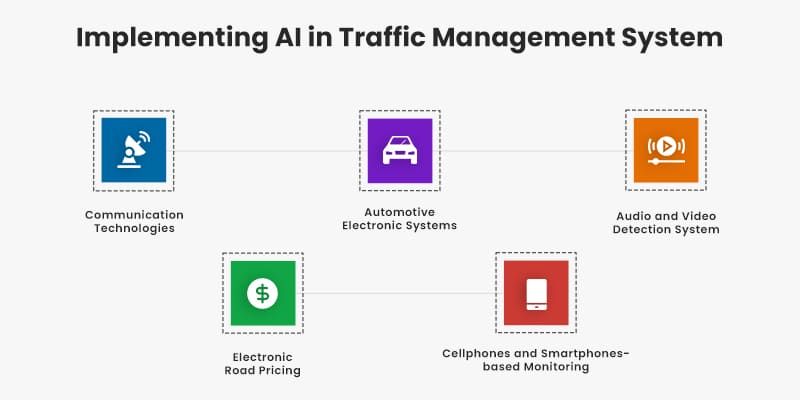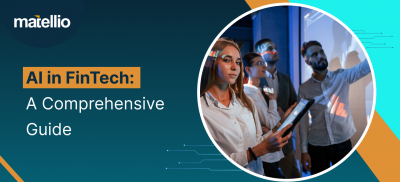
Did you know every US citizen is wasting 97 hours of their time in a year stuck in traffic? And as if sitting and fuming aren’t enough of a torment for them, they’re also losing USD 1,348 in wasted fuel! Traffic is getting worse with time, making next-gen solutions like AI in traffic management the need of the hour.
The solution is primarily based on using AI development services to analyze real-time data from urban transportation networks. This data includes the speed with which a vehicle is moving, the number of vehicles staying in one place at a given time, and the manual updates sent by the drivers and commuters. An artificial intelligence traffic control system then evaluates all this data to warn the new drivers about the bottlenecks on their way. This way, they can avoid that particular path, reaching their destination quicker. Less oncoming traffic will also ensure that the congestion doesn’t become worse and resolves quicker.
Benefits of Using AI in Traffic Management

Like every other sector, Artificial Intelligence has the potential to solve many of the time-tested challenges faced by traffic management controllers.
Quick Passage to Emergency Vehicles
Often, busy roads connecting residential areas to emergency services get clogged during peak hours. As such, it becomes difficult for one to avail themselves of emergency services like fire tenders, police, and ambulances. Historically, sirens and traffic laws governing the passage of such emergency vehicles have been used to deflect delays. However, in case of heavy traffic jams, none of those rules help. Here, an intelligent traffic management system with route selection optimization is the best help. Such a system can plan the best route for the drivers in advance to reach the place in distress in the shortest time. Real-time data analytics can also be used here to alert the drivers about the road blockages and traffic congestion on their route so they can divert to a different one.
Traffic Law Enforcement
Artificial Intelligence Traffic Control is the most promising area where the technology is transforming traffic management administration. Here real-time data from road surveillance cameras can be collected to detect disobedience of traffic rules. Such a smart ITMS can automatically detect whenever it captures rule disobedience and then alert the officers if the manual interception is required. In most other cases, the cameras will automatically capture the vehicle registration number and supporting evidence information to send the penalty notice to the registered owner of the vehicle. What’s interesting here is that more than enforcing the law post-lapse in following the rules, such a system actually works as a perfect deterrent among drivers from breaking a traffic rule. Since such an Artificial Intelligence Traffic Control system is far more vigilant and accurate than any of their traditional counterparts, drivers stay diligent in following all the traffic laws lest they get captured doing something wrong.
Dynamic Traffic Light Sequencing
One of the major sources of distress and frustration among the drivers on the road is traffic stop lights. The static sequencing of traffic lights on intersections provides traffic flow on all the roads with the same amount of time to pass through. This leads to an inefficiency where a column with heavy traffic flow has to wait for its turn to move ahead even if the other column has no traffic at all. By using RFID for dynamic traffic light sequences, such instances can be avoided by real-time analysis and automation. The technology can also be used on multi-vehicle, multi-lane, and multi-road junction areas to emulate a traffic officer for a more time-efficient scheme.
Achieve Smart City Goals
In addition to controlling the traffic flow better, another application of artificial intelligence in traffic control is that of implementing smart city goals. Cameras and other edge devices can be integrated to create a smart tracking system that can identify the least-efficient vehicles by tracking their path, speed, and emission. Based on these factors, automatic notices can be issued to vehicle owners to service their automobiles for better performance. Additionally, all other vehicles can be notified to avoid traffic congestion and the traffic signals ahead of them. This will help them eliminate inefficient use of fuel, helping the city achieve its emission and environmental sustainability goals.
Intelligent Parking Planning
For regular commuters as well as logistics transportation, finding appropriate parking spaces wastes a lot of time, unnecessarily consuming their productivity resources and time. To resolve this issue, many companies are actively investing in smart parking systems. These systems can help drivers find a parking space quickly, saving time spent in the search for them. Other than that, with predictive analytics, they can also be notified of the occupancy levels of a particular parking lot, so they can time their trip in advance to save both time and resources. This solution requires more investments and large-scale data collection from the smart city development point of view. However, companies engaged in logistics operations can benefit largely by automating their workflows with all the data available in-house. This is why, when it comes to smart parking solutions, enterprise software development is a more lucrative option.
Urban Planning
More often than not, most frequent congestion happens because of inefficient infrastructure facilities. And while administrations are managing this by building new roads and columns in heavy-traffic-flow areas. However, their decision-making process is still not in the most efficient stage. Thanks to a lack of data and intangible variables, huge investments in infrastructure do not yield as effective results. However, with AI in traffic management systems, urban planning can be improved to a whole new level. New infrastructures can be built by analyzing big data on the historical traffic congestion on different routes. The effectiveness of new support systems can also be analyzed before implementation. AI developers can build models with exploratory data analysis and predictive analytics to understand how people move around the city. This way, they can create solutions that consider all the different independent variables even when developing the solution.
Implementing AI in Traffic Management System

To effectively implement AI in traffic management, logistics businesses and urban planners can use a variety of technologies. The major ones are discussed below-
 Communication Technologies
Communication Technologies
The most common applications of artificial intelligence in traffic control use wireless communication technologies UHF and VHF. These short-range communication technologies are used to facilitate car-to-car communication. The benefit here is that these do not depend on the internet or any telecommunication network. Therefore, whenever a convoy has to use a smart way to communicate in real-time for spontaneous cases like oncoming traffic or a roadblock, they can use this application of AI in logistics and transportation to make decisions quickly. Infrastructure networks such as the internet, GSM, etc., are used for longer-range communications.
 Audio and Video Detection System
Audio and Video Detection System
Video transmission of real-time traffic data is one of the most effective and most used ways to implement AI in traffic management systems. These cameras are mounted on poles and other structures adjacent to roadways to get a holistic view f the running traffic. They can automatically detect incidents and, at the same time, capture the license plate number from the vehicle. Another similarly effective yet comparatively less used is the method of audio detection. Cumulative sounds from engine noise, tyre noise, honks, and air turbulence noise can be gathered to estimate the state of traffic in a given area. This data, combined with data from video capturing devices, can strengthen the quality and accuracy of Incident detection.
 Automotive Electronic Systems
Automotive Electronic Systems
This utility of AI in traffic management is concerned more with individual vehicles than the entire artificial intelligence traffic control. An automotive electronic system is usually used in smart automobiles to manage engine, ignition, radio, telematics, navigation, and in-car entertainment elements. The navigation part of the system can be used to assist drivers in making better traffic decisions through sensors and cameras. The system can help drivers to stay in the correct lane, drive in the accepted speed range, assist with parking through blind-spot detection, etc.
 Electronic Road Pricing
Electronic Road Pricing
Amid the constant growth of single-occupancy vehicles on roads, urban planners can use electronic road pricing systems to discourage drivers from cruising busy streets unless necessary. The system uses AI for traffic management by automatically billing cars that enter a specific city area. Such a solution has been in place in Singapore since 2010. The system has already helped the country in managing the optimal speed on arterial roads and expressways, minimizing the probability of congestion effectively. The system uses sensors and cameras to capture the license plate numbers of all entering vehicles to send the bills to their registered residences. Furthermore, dynamic pricing has also been implemented to charge varying prices on the road during peak hours and freer times.
 Cellphones and Smartphones-based Monitoring
Cellphones and Smartphones-based Monitoring
Another simple way of implementing a smart traffic management system based on artificial intelligence utilizes data from public smartphones. Unidentified real-time information from devices’ accelerometers, microphones, GPS, etc., can be used to evaluate the traffic speed, density, and even the quality of the road. Already Google maps are using this as a source to predict congestion and help drivers avoid bottlenecks on the way to their destination. Logistics businesses and the city’s traffic administration can also use the same source to build smart solutions. Similarly, even the continuous transmission of the signal from cellphones can be used to ascertain traffic congestion. Cell-sectors can use triangulation and pattern-matching methods to formulate statistics to see the status of newer connections in the area and gather traffic flow information from it.
Also Read- Things to Consider before Implementing Smart Traffic Management System
Wrapping Up
Traffic systems are chaotic by nature. No matter how many new policies have been implemented, both urban administration and logistics businesses are struggling to evade traffic congestion and subsequent wastage. The root cause is that no policy can effectively consider all the different variables like weather, holiday traffic, population changes, and infrastructural development. Besides, if a policy is indeed made with all these factors in mind, the changes will take so long to come into effect that the results are often rendered inefficient. This is why next-gen technologies like AI software development have become the need of the hour.
A custom solution of AI in traffic management can consider far more variables in real-time and make decisions for even future planning through predictive analytics to make traffic control more effective and efficient for all the parties concerned. AI developers can build smart models on the basis of factors like pedestrian flow, unplanned events, road blockages, etc., to offer drivers real-time insights and help them pick the better routes when on the way. AI-based traffic management software development can also be integrated with intelligent traffic management systems and predictive models to help companies plan their logistics schedules and route for greater efficiency.
Matellio, with its trackable experience in logistics software development and AI expertise, can prove to be a great help here. The industry experts here understand the intricacies involved in the chaotic world of traffic systems and thus build solutions that befit its specific requirements. As a leading enterprise software development company, we have helped many businesses in optimizing their logistics operations by offering them a comprehensive view of their system and enhancing its functionalities with technologies like AI/ML, IoT, Blockchain, and more. If you’re interested in developing a custom solution for AI in traffic management, all you need to do is fill out this form with your ideas and requirements. Our experts will analyze the same to book a free consultation call and send a development plan with a free quote too.

 Communication Technologies
Communication Technologies Audio and Video Detection System
Audio and Video Detection System Automotive Electronic Systems
Automotive Electronic Systems Electronic Road Pricing
Electronic Road Pricing Cellphones and Smartphones-based Monitoring
Cellphones and Smartphones-based Monitoring


